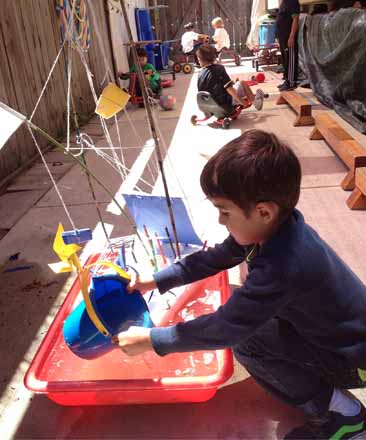
We built cargo-ships complete with windows, smokestacks, and smoke, then floated them in water, loaded up cargo, and pretended to carry it to port. This helped our kids to adopt the common language, and made expanding and sharing their ideas more enticing and accessible for all!
We continue to be amazed at how strongly a theme-based curriculum allows our kids’ to make connections of two kinds: one, in connecting to one another through authentic, child-led social interaction, and two, in making connections in their own ideas, sharing them, and broadening their understanding of the world through play.
As adults, we can build simple bridges between the language environment and the physical environment, social environment by creating a “common language” across activities.
This week we followed up on circle time songs and interactive book reading about boats with a hands-on art project and opportunities for free play infused with the same vocabulary and related materials. We built cargo-ships complete with windows, smokestacks, and smoke, then floated them in water, loaded up cargo, and pretended to carry it to port. This helped our kids to adopt the common language, and made expanding and sharing their ideas more enticing and accessible for all.

As adults, we can build simple bridges between the language environment and the physical environment, social environment by creating a “common language” across activities.
In the same way that our kids’ common language can spark social and intellectual growth, we’ve begun to notice how speaking a common language in the way we as staff and parent-partners see and talk about the kids, allows us to reflect and collaborate more effectively. Talking about our group’s activities and children’s participation after-the-fact is an important aspect of this reflective/collaborative process.
During staff wrap-up this week, we discussed one student’s difficulty remaining seated with his friends during snack time. After sharing observations, we realized that he had showed keen interest in another group of peers engaged in outdoor play in view and earshot of the snack table. This competing interest had won out over his physical presence at snack! We made a plan to model language at his level that would help him share his intent with staff and peers. Then we joined him in commenting on the outdoor play to expand upon and build language around his interest. Sharing his natural interest helped this student connect more fully with his snack-mates and teachers. We could see his pride and confidence immediately!
By sharing this unconditional positive regard (Rogers, 1961) for the kids, we cultivate healthy relationships. Relationships become the support structure for children’s development of capacities that will serve them throughout their lives. We, as adults, share responsibility to provide the rich experiences, and empathic guidance that allow our kids to connect more fully to their world through learning; open communication and reflection on our intervention and parenting “practices” is a key element in guiding our children with “just right” supports.
-Lucas Hehemann
Rogers, Carl. On Becoming a Person, pages 283-84. Boston: Houghton Mifflin. 1961.
